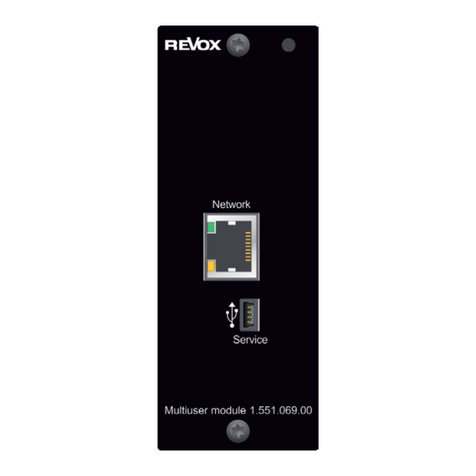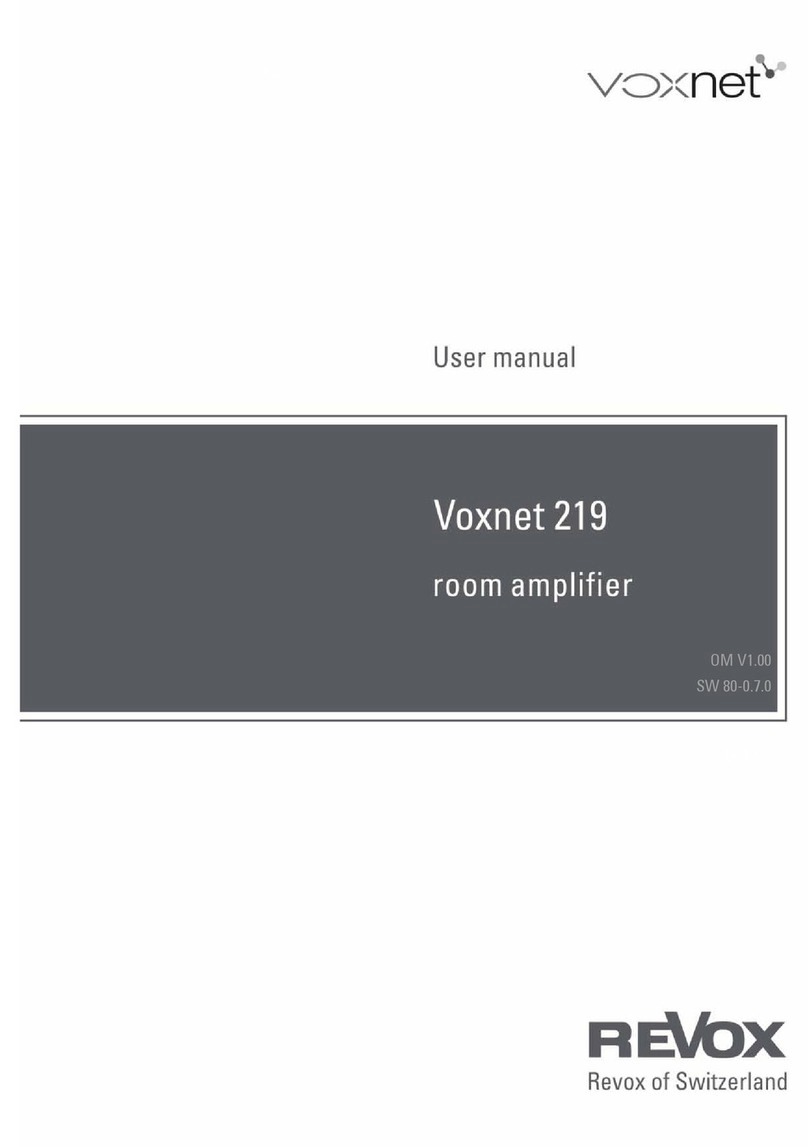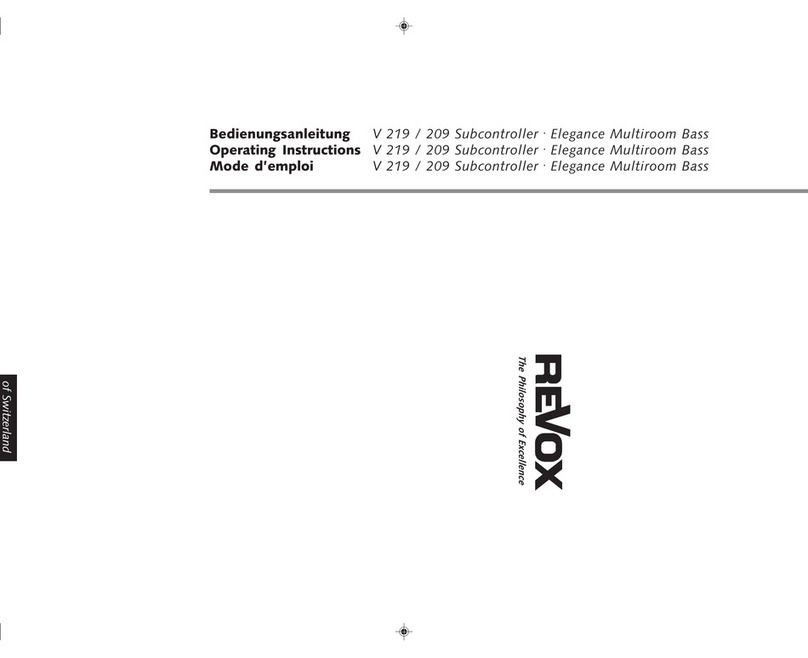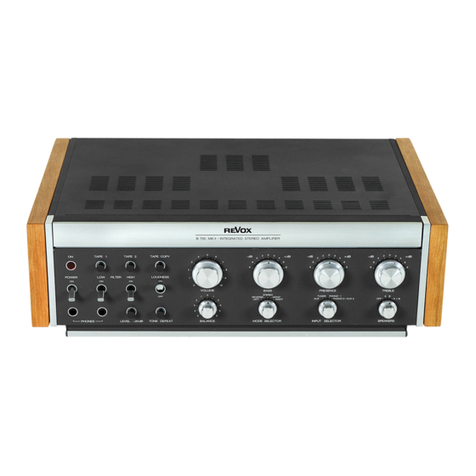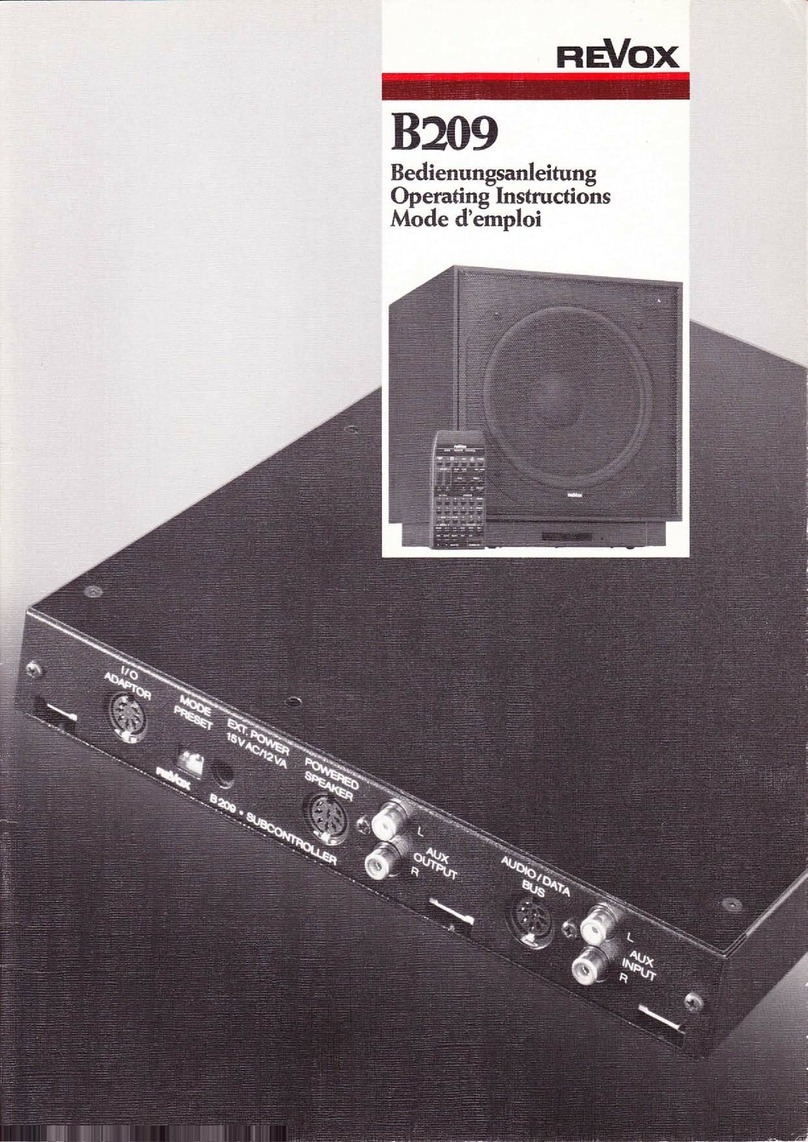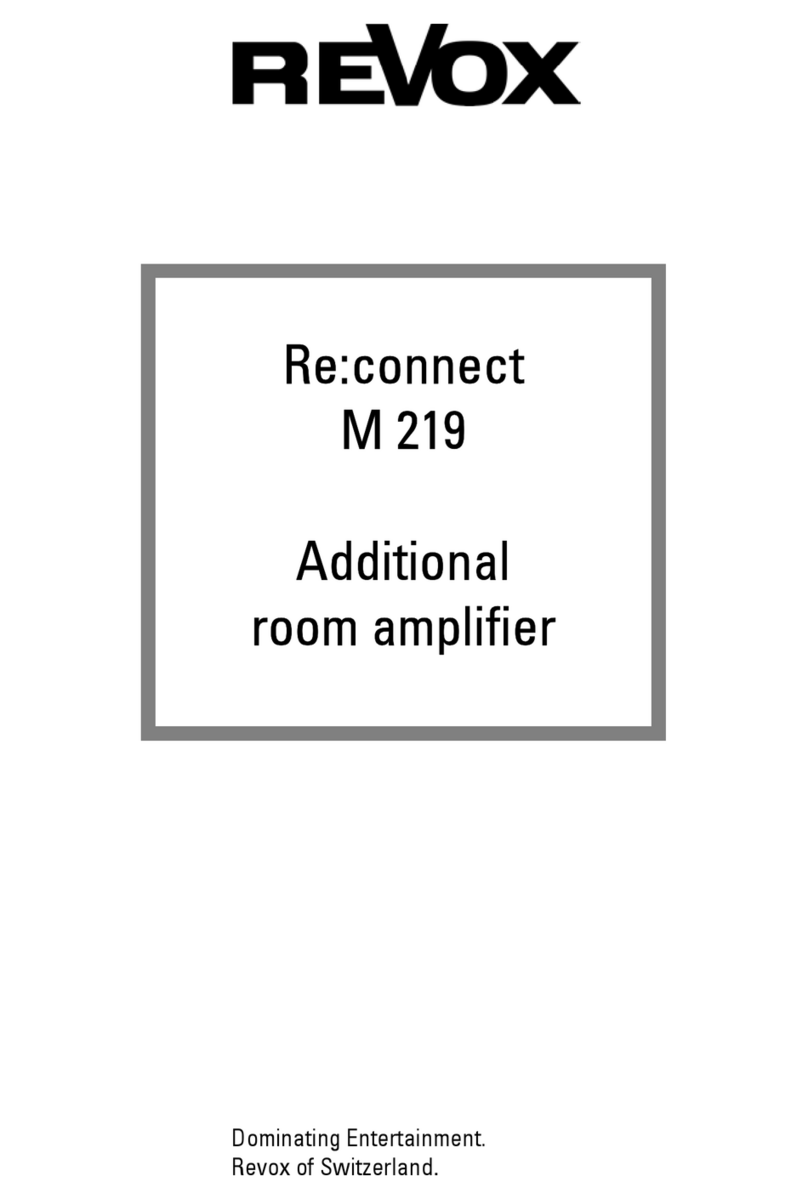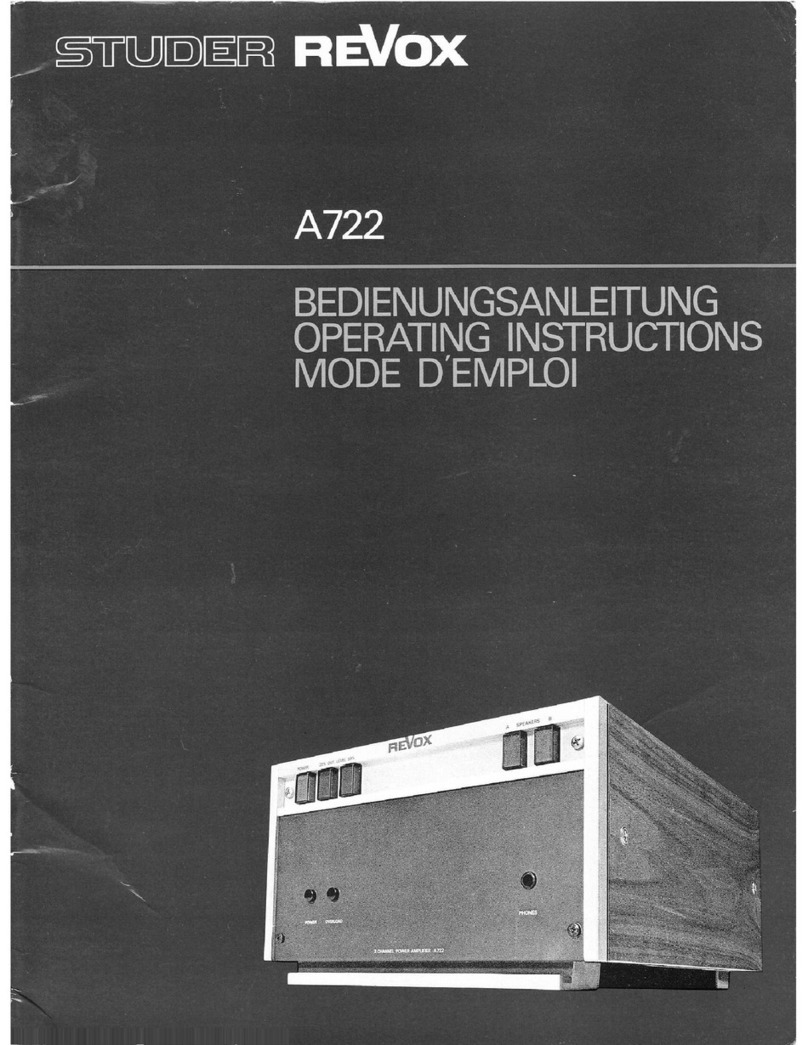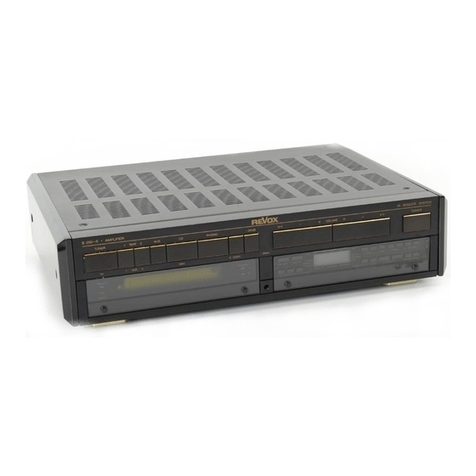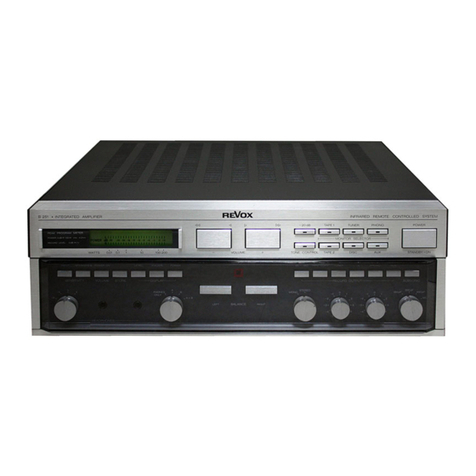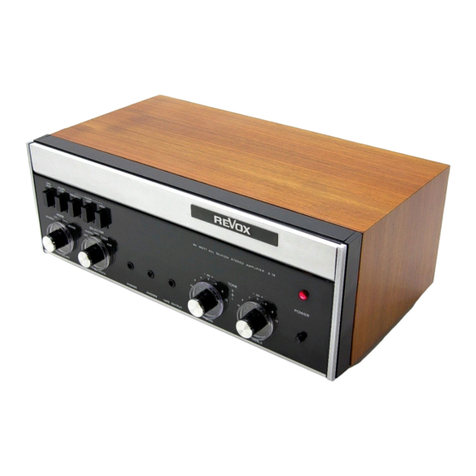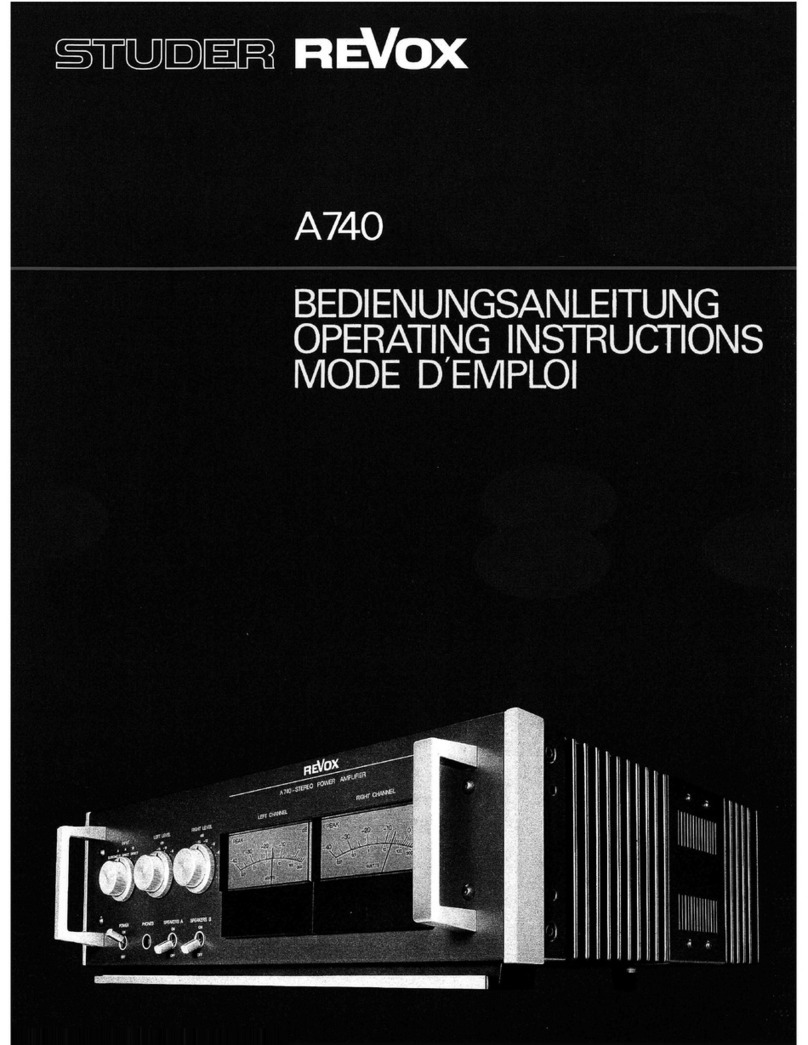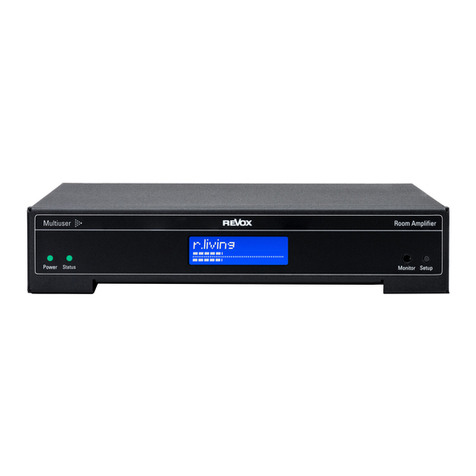
Flffi A5tl xfüiiflEi;:,- eäü{,hfr'{,äü[#:
SERVICE.ANLEITUNG SERVICE SHEET I NSTRUCTIONS DE SERVICE
FUNKTIONSBESCHREI BUNG
1. Eingangsstufe 1.078.110
Die Eingangsstufe enthält Vorverstärker
und Entzerrer. Die Empfindlichkeit der
einzelnen Eingänge wird je nach Stellung
des Einaanqswahlschalters durch eine vari-
able Gegenkopplung bestimmt. O101 ist
ein rauscharmer pnp ' Transistor, dessen
Emitter im Gegenkopplungszweig der gleich-
stromgekoppelten Stufe liegt. ln der Kas-
kadenschaltung von 0102 und 0103 wirkt
0103 als Kollektorwiderstand mit grosser
lmpedanz für NF-Signale und geringem
Gleichstromwiderstand. Durch die Gleich-
stromgegenkopplung über R106 wi;d ein
stabiler Arbeitspunkt gewährleistet. Die
PHONO-Entzerrung (RIAA-lEC) erfolgt
durch die RC-Glieder R114-C109, R'115
und C'110 im NF-Gegenkopplungszweig
und F106 im Gleichstromzweig. ln Stellung
TAPE, TUNER und AUX ist die Gegen-
kopplung frequenzunabhängig (R1 18). ln
Stellung MICRO ist die Gegenkopplung
ausgeschaltet. Die einzelnen Tonspannungs-
quellen werden mittels Vorreglern einge-
pegelt: in Stellung PHONO wird die Gegen-
kopplung variiert. Die [i]ICRO-Eingänge
sind nicht regelbar und sind an den Buch-
sen parallel geschaltet, Bei Verwendung
von Stereo-Mikrophonen oder einem l\4ikro-
phon pro Kanal ist die Verbindung zu
lösen. Der Ausgang des Entzerr-Vorver-
stärkers führt auf den Betriebsrtenschal-
ter: MONO/STEREO/CH l/CH ll.
2. Filterstufe 1.O7A.172
Die als aktives Filter geschaltete Stufe mit
Transistor O201 als Spannungsfolger be-
wirkt eine Tiefendämpfung lC2O2, R202,
C203, R2O3, R204) und Höhendämpfung
(R2O5, C2O4, R207, C2O5). Das LOUD-
NESS LOWFilter bewirkt eine Absenkung
des NF-Pegels bei gleichzeitiger physiolo-
gischer Frequenzgangkorrektur. Die TAPE
IVIONITOR-Taste schaltet den Vorverstär-
ker ab und verbindet den Eingang TAPE
MONITOR über Loudness-Filter und Klang,
regler mit den Endstufen (Hinterbandkon-
trolle). Der Ausgang der Filterstufe führt
aul den Lautstärkeregler und die Ausgänge
TAPE OUTPUT. Auf dem gleichen Print
befinden sich auch die Schatter SPEAKERS
OFF.
3. Klangreglerstufe 1.078.106 - 1.078.215
Die Stufen 0301 und O3o2 arbeiten in
Mittelstellung des Balancereglers mit einer
Verstärkung von 20 dB. Die Balanceregelung
erfolgt im Gegenkopplungszweig dieser Stu'
fen. lm Gegenkopplungszweig der Stufe
0303-0304 befindet sich das Netzwerk
für die Anhebung, bzw. Absenkung der Hö-
hen und Tiefen.
4. Treiber. und Endstufe 1.078.114
Die NF-Signale gelangen an die Basis des
Transistors O501, der in normaler Emitter-
schaltung arbeitet. Das verstärkte Signal
wird am Kollektorwiderstand R504 abge-
nommen und direkt an die Basis des
Transistors O502 geführt, welcher eben-
falls in Emitterschaltung arbeitet. Die
Stromgegenkopplung am Widerstand R508
wird für NF durch Kondenstor C502 auf-
gehoben. Da der Kollektorwiderstand R509
infolge der Bootstrap,Wirkung von C503,
sowie der hohen Eingangsimpedanz der
Transistoren 0503 und 0504 sehr gross ist,
erreicht diese Stufe eine Spannungsver-
stärkung von gegen 60 dB. Die obere Über-
tragungsfrequenz wird daher durch die
lokale Gegenkopplung mit C505 massge-
bend bestimmt. Durch die nichtlineare
Charakteristik der Dioden D501 und D502
wird eine stabile Basis,Emitterspannung der
Treibertransistoren und damit eine von der
Betriebsspannung weitgehend unabhängige
Arbeitspunkteinstellung erreicht, Die ther-
mische Kurzzeitstabilität wird durch R514
und R51 5 erzielt; die Langzeitstabilität wird
durch die thermische Kopplung der Dioden
D50'1 und D502 mit dem Kühlkörper der
Leistungstransistoren erreicht. Bei grossen
Aussteuerungen werden die Dioden D504
und D505 leitend, womit zu jedem 1S2 - Wi-
derstand ein 0.47O-Widerstand parallel ge
$haltet wird. Die Spannungsfestigkeit der
Leistungstransistoren 0505 und Q506 wird
durch die Widerstand-Diode,Kombination
im Emitterkreis künstlich erhöht ( 0505 :
R514-R528-D504, 0506 : R516 D506 ).
Spule L501 und Boucherot-Glied R518,
C506 sichern ein stabiles Verhalten der
Endstufe, auch bei extremer kapazitiver
Last bis zu 'l trrF, sowie ein optimales
Rechteckverhalten bei höchsten Frequenzen
und voller Leistunq.
5. Netzteil 1.078.235
Die Speisung der Endstufen erfolgt sym-
metrisch (+41 V und -41 V), mit kapazi-
tiv erzeugtem Mittelpunkt. Diese elektrische
lilitte ist lediglich über die Abschirmung
der NF-Zuführung mit der Masse der Vor-
stuf en-Stromversorgung verbunden.
Ein kurzschlusssicheres, stabilisiertes Netz-
teil gewährleistet eine brumm'und rausch-
freie Spannung uon 24 V. Die Verbindung
Mdsse ru Gerätecha$is erlolgt nur an einem
Punkt: der Lötfahne zwischen den beiden
Kopfhörerbuchsen.
EINSTELLUNGEN
Die Pegelvorregler 19 bis 23 dienen zur Ein-
pegelung der verschiedenen Tonspannungs'
quellen. Diese Regler werden normalerweise
vom Besitzer des Gerätes eingestellt. Die
restlichen Einstellungen beziehen sich auf
die Endstufen.
1. Gleichspannung am Lautsprecherausgang:
- Verstärker ohne Last. nicht angesteuert,
- DC-Voltmeter am Lautsprecherausgang
anschliessn und mit Trimmpotentio-
meter R51 9 auf 0 V 1 50 mV abgleichen.
2. Ruhest.om der Leistungstransistoren
Zweites DCVoltmeter parallel zu R514
an den Messpunkten auf Lötseite {r bei
Steckerleiste, am oberen Rand) an-
schl iessen.
- l/lit Trimmpotentiometer R520 einen
Spannung*bfall von 20 mV einstellen
(= 20 mA an 1 Q).
Diese Einstellungen zeigen eine leichte
Abhängigkeit voneinander und sollen des-
halb wechselweise im Kaltzustand des
Gerätesvorgenommen werden. Eine nach-
trägliche Abweichung von diesen Werten
bei erwärmtem Gerät ist belanglos und
soll nicht korrigiert werden.
FEHLERSUCHE
1. Verstärker gpnz ausgefallen
ln den meisten Fällen lst der Ausfall des
Verstärkers auf einen Defekt der Endstufen
zurückzuführen.
Eventuell durchgebrannte Netzsicherung er-
setzen und Verstärker über Regeltrenntrafo
und Wattmeter an das Netz anschliessen.
Regeltrafo langsam hochdrehen, bei gleich-
zeitiger Beobachtung der Leistungeufnah-
me am Wattmeter; grössere Abweichungen
des nominalen Leerlaufwertes (12 W) nach
oben oder nach unten lassen auf defekte
Endstufen rchliessen. Nlessung der Span-
nungen und Ströme der verdächtigten Stu-
{en vornehmen.
Spannungen an den Elkos C906 und C907,
bzw. C926 und C927 vergleichen: wird
ein Unterschied von mehr als 10 % ge-
messen (2.B. 30V an C906 und 50V an
C907), Gerät ausschalten und beide Treiber-
prints 1.078.114 herausnehmen. Mit dem
Ohmmeter (auf Polarität achtenl) die Sperr-
schichten der npn-Endtransistoren kontrol-
lieren: das lnstrument zeigt einen Ausschlag
bei positiver Basis gegenüber Emitter oder
Kollektor. Bei negativer Basis gegenüber
Emitter oder Kollektor, sowie negativem
oder positivem Kollektor gegenüber Emltter
zeigt das lnstrument keinen Ausschlag.
Der Ausfall eines Treibertransistors hat
meist einen Durchbruch der Endtrdnsistoren
zur Folge und umgekehrt. Treibertransisto-
ren kontrollieren und Kontaktgabe der
Trimmpotentiometer-Schleifer überprüfen.
2. Verstä.ker arbeitet schlecht
Ubersteigt der Klirrfaktor bei 1 kHz den
maximal zugelassenen Wert von 0.1 % bei
40W, so ist Transistor 0502 defekt. Tritt
ein Tiefenabfall von mehr als 1 dB bei 20 Hz
auf, so ist C501 zu ersetzen.
lst bei hohen Frequenzen der Klirrfaktor
zu hoch oder der Frequenzgang schlecht,
oder zeigt eine 10 kHz-Rechteckspannung
bei rein ohmscher Last ein überschwingen,
so sind die Kondensatoren C504, C505 und
C506 zu überprüfen.
Nach jeder Reparatur muss der Spannungs
dbfall an den drei I Q-W;derständen bei einer
Leistung von 40W gemessen werden. Es
zeigt sich dabei, ob die drei dazugehörenden
Dioden noch funktionsfähig sind.
Nominalwerte : An R514 ( (Testpunkte )und
R515i 600-700 mV, an R516: 450-500 mV.
Die Überschreitung dieser Werte lässt er,
kennen, dass die entsprechende Diode un-
terbrochen ist. Der Durchbruch einer Diode
zeigt sich durch eine Unterschreitung der
Nominalwerte an R514 und R515, bzw.
durch einen sehr kleinen Spannungsabfall
an R516.
CIRCUIT DESCRIPTION
1. lnput stage 1.078.110
The input stage consists of preamplification
combined with equalization networks. The
*nsitivity of the various inputs is deter-
mined by varying amounts of negative
feedback which depends on the position of
the input selector, O10'l is a low noise pnp.
transistor whose emitter is in the feedback
circuit of the direct coupled ampl ifier stage.
The transistor 0103 in the cascade con'
nection of 0102 and 0103 acts as the
collector resistor with a high impedance for
audio signals, while representing a low DC
resistance. A stable operating point is en,
sured by DC feedback via the R106 resistor.
Phono equalization (RIAA-lEC) is given by
the RC'network R114-C109, R115 and
C1 10 in the audio feedback circuit, as well
as by R106 in the Dc-path. With the selec-
tor in positions TAPE, TUNER and AUX
feedback occurs via R118 and is not
frequency slective. With the selector in
position l\illCRO, feedback is completely
diebled. Level matchinq of rhe various
pund sources is achieved by means of
preset input controls; only in posjtion
PHONO is this done by varying the amount
of feedback. The micro inputs are con-
nected in parallel at their input sockets and
there is no provision for level preadjustment-
When using stereo microphones, or one
microphone per channel, the parallel con-
nection at the microphone input is to be
removed. The output of the equalizer-
preamplifier connects to the mode selector
switch MONO/STEREO/CH l/CH ll.
2. Filter stage 1-078.172
The active filter stage, with transistor O20l
forming an emitter follower circuit, provides
low frequency attenuation by C2O2, R2O2,
C203, R203, R204 and high frequency
attenuation by R205. C2A4, R2O7, C2O5.
The LOUDNESS LOW-Filter effects a basic
reduction of the audio level, while simul-
taneously introducing physiological fre-
quency respons correction. The TAPE
MON|ToR-button dirconnects the pream-
plifier and provides a direct signal path from
the input TAPE MON ITO R via the loudness
filter and tone controls to the output stages
for off tape monitoring, The output of the
filter stage connects to the volume control
and to the sockets TAPE OUTPUT as
well. The buttons SPEAKEFS OFF are
accommodated on that print as well.
3. Tone control stage'1.078.106-1.078.21S
With the balance control in center po-
sition, the two transistors 0301 and O3O2
will provide 20 dB of gain. Balance
control is achieved in the feedback path of
those two stages. The network for bass and
treble control is located in the feedback
circuit of the amplifying stages formed by
0303 and 0304.
4. Driver and power output stages 1 .O7A,114
The audio signal is fed to the base of
transistor O50l which operates in a con-
ventional common emitter circuit. The
a mp I ified signa I devel ops across th e col lector
resistor R504 and is directly fed tothe base
of Q502 which operates also in a common
emitter configuration. The effect of current
feedback due to R508 is by-passed for audio
frequencies by C502, Because the collector
resistor R509 is high as a result of the boot-
strap effect caused by C503 and the high
input impedance of the trsnsistors 0503
and Q504 an overall voltage gain of 60 dB
is reached by that stage. The iocal
feedback action of C502 drides
the upper frequency limit. As a
result of the non linear characteristic of
the diodes D501 and D502 a stable base
emitter voltage is determined for the driver
transistors and with it, an operatinq point
which remains uneffected by wide fluc-
tuations of the supply volrage. With R514
and R515 thermal short term stability is
achieved ; long term stability is obtained
bythermal couplingof the diodes D501 and
D502 to the heatsink of the power tran,
sistors. At large signal levels, the diodes
D504 and D505 become conductive, there-
by connecting a 0,47Q resistor in parallel
to each of the 1f, resistors. The break-
down voltage of the power transistors is
raised artificially by the resistor diod6,com-
binations R51 4- R528-D504 and R51 6-D506
in the emitter leg of 0505 and 0506 respec-
tively. Stable operation of the output stage
with capacitive loads up to lgF as well as
optimum square-wave response up to the
highest frequencies at full output power is
ensured by coil L501 and the Boucherot
circuit formed by the R518-C506 RC
combination-

